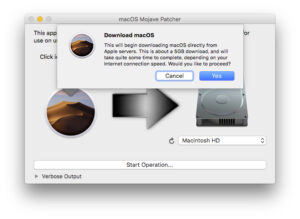

*Ensure that the tool successfully verifies the app.ģ. Open the "macOS Mojave Patcher" tool, and browse for your copy of the macOS Mojave Installer App. Insert your desired USB drive, open Disk Utility, and format it as OS X Extended (Journaled).Ģ.
MACOS MOJAVE PATCHER DMG UPDATE
When installing, ensure your system is plugged in to power, or the update will not be installed.ġ.
MACOS MOJAVE PATCHER DMG INSTALL
If you have NOT previously installed High Sierra, you can download and install this package to install the latest BootROM version. Important Note: If you have a machine that supports High Sierra natively, you MUST ensure you have the latest version of the system's BootROM installed if you want to boot from an APFS volume.

A USB drive that's at least 16 GB in size.In the Menu Bar, simply select "Tools > Download macOS Mojave." This can be obtained from the Mac App Store using a machine that supports Mojave, or by using the built-in downloading feature of the tool. A copy of the macOS Mojave Installer App.Using our Install Patch configuration, you can deploy the Mojave update to all the Mac devices in your network.You can find release notes for this version here: Now, the patch will be successfully uploaded to the patch store, and will be available for deployment.Navigate to the location of the downloaded patch file in and upload it.Apply the filter "Missing patches in the network" and find the 'Upgrade to macOS Mojave' option under 'Patch Description'. Here you will find a list of patches that have to be downloaded manually.Navigate to Patches > Downloaded patches > upload patches.(Note: This option is only available for the build 10.0.282 and above). In order to deploy the macOS Mojave patch to Mac devices missing the latest version, it is required to upload the installation file to our patch store using the following steps: Go to the Applications folder(as mentioned in the file path) and execute that exact command in that folder to compress the installation file. Note: The User should not execute the above command in some other directory. Compress the installation file using the following command.Find the installation file 'Install macOS Mojave' in Applications folder by navigating to the file path /Applications/.Click on the macOS Mojave icon and choose to download.Open App Store in one of the managed Mac devices.You can refer this link for more details : MacOS 10.14 Mojave System Requirements.Mac Pro (mid 2010 and mid 2012 models) must first be updated to macOS High Sierra 10.13.6 before updating to macOS Mojave.A minimum of 2 GB RAM memory is required.A minimum of 18.5 GB free space is required on the hard disk.Computer should be running on Mac 10.8 or later versions.You can upgrade your Mac operating system to Mojave 10.14, only if the following system requirements are met:
MACOS MOJAVE PATCHER DMG HOW TO
How to deploy a patch to upgrade Mac devices to the latest macOS Mojave? Description:Īpple has finally released macOS 10.14, named Mojave after one of California's three deserts. If your organisation is itching to upgrade Mojave update to multiple Mac devices, the Upload Patch feature lets you perform the deployment efficiently.


 0 kommentar(er)
0 kommentar(er)
